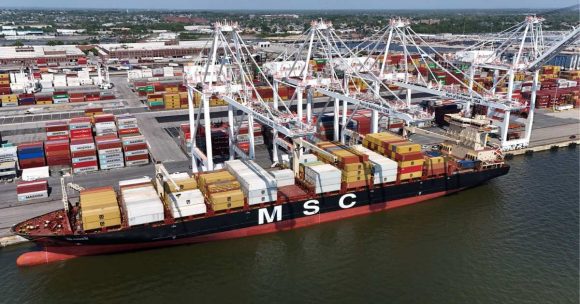The Port of Baltimore has announced container ships have begun to call at port following the bridge collapse last month. Shippers will be breathing a sigh of relief.
The Francis Scott Key Bridge on the Patapsco River in Baltimore was the scene of a maritime accident after a vessel, Dali, rammed into the bridge last month.
Last week, the Saimaagracht was the first vessel to successfully move through the temporary 35-foot deep channel from the Port of Baltimore’s public terminals.
In a Facebook post, the port highlighted another milestone: “Another milestone today! The first container ship to arrive at Ports America Chesapeake’s Seagirt Terminal since the crisis began.
“The MSC Mediterranean Shipping Co Passion III came through the 35-foot-deep temporary channel. Nearly 1,000 containers were handled by about 80 International Longshoremen’s Association workers. Great to see the ships coming back. We’re getting there.”
Ship channels at Baltimore
In initial reports, the National Transportation and Safety Board (NTSB) suspected a possible electric fault on board the Dali.
The port released another update last week, saying the 35-foot-deep Fort McHenry Limited Access Channel is not expected to be open until May 10.
“The US Army Corps of Engineers expects to open Port of Baltimore’s permanent 700-foot wide, 50-foot deep channel by the end of May.”
Forbes reported over 500 small businesses applied for federal loans following the maritime disaster.
Locate2u has been following events in the aftermath. US President Joe Biden visited the scene earlier this month. He promised the logistics sector that the government’s priority is to “open the port” as it’s the largest shipping hub for import and export.
Port of Baltimore services US trade needs
As one of the oldest ports in the United States, it has a long history of serving the nation’s trade needs and has evolved over time to adapt to changing shipping technologies and trade patterns.
The Bureau of Transportation Statistics reports that the Port of Baltimore is among the top 20 ports in the United States regarding tonnage and the number of containers handled. The report adds that it is the 10th largest port for dry bulk and a major hub for importing and exporting motorized vehicles.
The port has specialized facilities for handling various cargo types, including automobiles, RORO cargo, containers, and bulk commodities. It’s particularly renowned for its handling of cars and RORO cargo.
Transporting cargo by sea
There are several reasons why shippers select sea freight. This mode of transport offers several advantages.
- Suitable for diverse cargo: Sea freight can accommodate many cargo types, including bulk commodities such as agricultural products and minerals, oversized items (such as machinery and vehicles), and hazardous materials. Containers can be used to transport manufactured goods, electronics, and consumer products.
- Global reach: Shipping by sea offers extensive coverage, reaching ports worldwide. This makes it an essential mode of transport for global trade, facilitating access to international markets.
- Scalability: The flexibility and scalability of sea transport are significant advantages. Companies can choose from different ship sizes and types, adjust the volume of goods shipped according to demand, and benefit from the established logistics of international shipping lanes.
Photo Credit: Port of Baltimore (Facebook)
About the author
Sharl is a qualified journalist. He has over 10 years’ experience in the media industry, including positions as an editor of a magazine and Business Editor of a daily newspaper. Sharl also has experience in logistics specifically operations, where he worked with global food aid organisations distributing food into Africa. Sharl enjoys writing business stories and human interest pieces.











